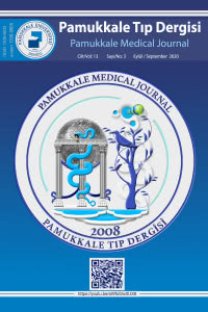İkinci basamak bir acil serviste trombolitik tedavi deneyimi
acil servis, trombolitik tedavi, alteplaz, tenekteplaz
Thrombolytic therapy experience in an secondary care emergency department
emergency department, thrombolytic therapy, alteplase, tenekteplase,
___
- 1. Rivera-Bou WL, Chersich A. The Role of Fibrinolytic Therapy in the Emergency Department. Boletin de la Asociacion Medica de Puerto Rico 2016;108:61-4.
- 2. Hasanoğlu C. Trombolitik Tedavi: Kime, Ne zaman, Nasıl. Güncel Göğüs Hastalıkları Serisi 2015;3:34-44.
- 3. Kunt R. Treatment with Intravenous Thrombolysis in Acute Ischemic Stroke Through the Perspective of a State Hospital. Türk Beyin Damar Hast Derg 2016;22:91-9.
- 4. Duggal R, Harger N. The safe and appropriate use of thrombolytics in the emergency department. US Pharm 2011;36:11-6.
- 5. Johnson M, Bakas T. A review of barriers to thrombolytic therapy: implications for nursing care in the emergency department. The Journal of neuroscience nursing : journal of the American Association of Neuroscience Nurses 2010;42:88-94.
- 6. Topçuoğlu MA, Arsava EM, Özdemir AÖ, Gürkaş E, Necioğlu Örken D, Öztürk Ş. Intravenous Thrombolytic Therapy in Acute Stroke: Problems and Solutions. Turk J Neurol 2017;23:162-75.
- 7. Ibanez B, James S, Agewall S, et al. 2017 ESC Guidelines for the management of acute myocardial infarction in patients presenting with ST-segment elevationThe Task Force for the management of acute myocardial infarction in patients presenting with ST-segment elevation of the European Society of Cardiology (ESC). European Heart Journal 2018;39:119-77.
- 8. Karaarslan S, Alihanoglu YI, Yildiz BS, et al. Appropriateness of the current guidelines on reperfusion treatment for patients applying to our hospital with ST-segment elevation acute myocardial infarction. Turk Kardiyol Dern Ars 2012;40:493-8.
- 9. Beton O, Zorlu A. Yoğun Bakımda Fibrinolitik Tedavi. Turkiye Klinikleri Journal of Cardiology Special Topics 2016;9:42-50.
- 10. Erkan L, Fındık S, Öztürk A, et al. Masif pulmoner tromboembolide trombolitik tedavi. Solunum Hastalıkları 2002;13:163-71.
- 11. Thrombolytic Therapy. 2017. (Accessed 08.12.2018, at https://emedicine.medscape.com/article/811234-overview.)
- 12. Bottiger BW, Bode C, Kern S, et al. Efficacy and safety of thrombolytic therapy after initially unsuccessful cardiopulmonary resuscitation: a prospective clinical trial. Lancet (London, England) 2001;357:1583-5.
- 13. Böttiger BW, Arntz H-R, Chamberlain DA, et al. Thrombolysis during Resuscitation for Out-of-Hospital Cardiac Arrest. New England Journal of Medicine 2008;359:2651-62.
- 14. Spohr F, Arntz HR, Bluhmki E, et al. International multicentre trial protocol to assess the efficacy and safety of tenecteplase during cardiopulmonary resuscitation in patients with out-of-hospital cardiac arrest: the Thrombolysis in Cardiac Arrest (TROICA) Study. European journal of clinical investigation 2005;35:315-23.
- 15. Abraham P, Arroyo DA, Giraud R, Bounameaux H, Bendjelid K. Understanding haemorrhagic risk following thrombolytic therapy in patients with intermediate-risk and high-risk pulmonary embolism: a hypothesis paper. Open Heart 2018;5:e000735.
- 16. Davydov L, Cheng JW. Tenecteplase: a review. Clinical therapeutics 2001;23:982-97; discussion 1.
- 17. Melandri G, Vagnarelli F, Calabrese D, Semprini F, Nanni S, Branzi A. Review of tenecteplase (TNKase) in the treatment of acute myocardial infarction. Vascular health and risk management 2009;5:249-56.
- 18. Kline JA, Nordenholz KE, Courtney DM, et al. Treatment of submassive pulmonary embolism with tenecteplase or placebo: cardiopulmonary outcomes at 3 months: multicenter double-blind, placebo-controlled randomized trial. Journal of thrombosis and haemostasis : JTH 2014;12:459-68.
- 19. Kline JA, Hernandez-Nino J, Jones AE. Tenecteplase to treat pulmonary embolism in the emergency department. Journal of thrombosis and thrombolysis 2007;23:101-5.
- ISSN: 1309-9833
- Yayın Aralığı: 4
- Başlangıç: 2008
- Yayıncı: Prof.Dr.Eylem Değirmenci
Pediatrik metabolik hastalıklarda kardiyovasküler bulgular
Çağdaş Erdoğan, Zeynep Ünlütürk
Antalya Eğitim ve Araştırma Hastanesi multipl skleroz polikliniğinin oral tedavi deneyimi
Burcu Yüksel, Fatma Kurtuluş, Abidin Erdal
Selçuk Yüksel, Neslihan Yılmaz
Detection of the 5HT2C polymorphism in myocardial infarction and cardiovascular event patients
İbrahim Açıkbaş, Dursun Dursunoğlu, Ayşen Buket Er Urgancı, Asuman Kaftan
Sol ventrikül nonkompaksiyonu:Manyetik rezonans görüntüleme bulguları
Furkan Ufuk, İsmail Doğu Kılıç, Hüseyin Gökhan Yavaş, İbrahim Hasbey
İkinci basamak bir acil serviste trombolitik tedavi deneyimi
Mehmet Ali Aslaner, Necmi Baykan
A case report of acute infantile hemorrhagic edema with adenovirus infection
Selçuk Yüksel, İlknur Girişgen, Kadriye Yalçın, Neşe Çallı Demirkan, Meltem Polat
